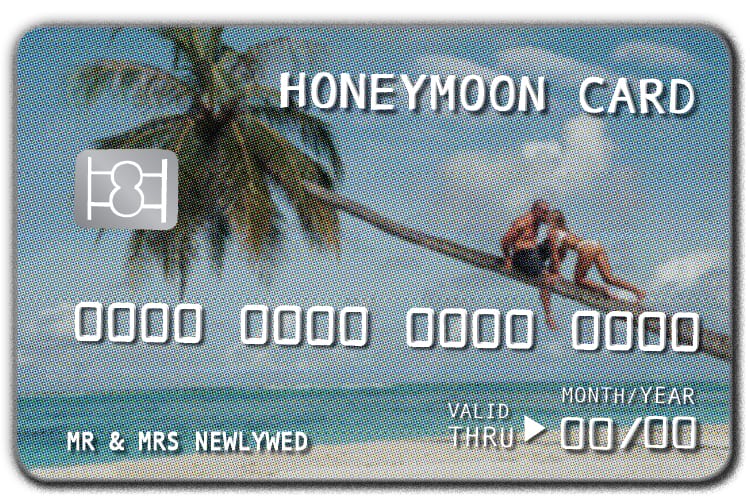
As honeymoons have evolved, so has the approach to funding one. Yes, you can still pay for it yourself (it’s customary for the groom to fund the honeymoon), but you can also leverage the power of a honeymoon registry, inviting your wedding guests to help you turn what would have been a lovely trip to a nice beach somewhere into a first class visit to a private island in the Maldives.
The word “honeymoon” comes from the medieval tradition of the bride and groom drinking mead, a honey wine that was thought to be an aphrodisiac, for a full cycle of the moon after the wedding night. The bride’s father would typically include a month’s supply of mead in her dowry, and the couple was allegedly prohibited from doing anything other than drinking mead and enjoying one another’s company until the bottles ran dry.
The idea of the honeymoon has evolved quite a bit since, but the goal is still to engage in an incredible experience with someone you care about, shake off the stress of the wedding week and, in theory, have a lot of sex—with or without the mead.
So where does the honeymoon registry come in? Because many couples cohabitate before getting married, they no longer need to register for items for a new home. In the same way your father’s business partner might opt to buy you and your wife a punch bowl you’ll never use, you can instead shuttle his largesse into your post-wedding war chest. Honeymoon registries are simple to set up and in many cases cost you nothing but time. In theory, you only get one honeymoon. Why not do whatever you can to make it a once in a lifetime trip that lives up to the billing?
To set up your honeymoon registry, first decide which site you want to use. There are several options, each with their own perks, but generally they all follow a similar format: Your honeymoon is broken up into different pieces (the room, a candlelit dinner, a helicopter tour), which all have an associated cost. Those visiting your registry can then pay for a portion (or all) of the piece. You receive the money and then apply it to its specified purpose. Voila—honeymoon funded, via direct deposit, PayPal, a direct payment to your chosen venue or cold hard cash, depending on the site you use and the options you choose.
Just like a traditional registry, once an item has been purchased on your behalf, it’s noted as “complete” so that folks aren’t buying you 34 couples massages. Also like a traditional registry, it’s considered gauche to announce to your wedding guests that you have one for your honeymoon. It is, however, within the bounds of etiquette to provide a link to the registry on your wedding website (another solid reason to create one).
So which site should you use? It largely depends on personal taste as well as the type of honeymoon you want to have. Below is a rundown of some of the options.
Wanderable
One of the most popular honeymoon registries, Wanderable acts as a combination registry and travel agent, and is great for couples who are starting their honeymoon planning from scratch. Your registry homepage is fully customizable, and the trip-planning aspect of the site is great as full itineraries are available for you to choose from. For those couples that have no idea where they want to go, only when their honeymoon is theoretically taking place, some possible itineraries are even organized by month. Gifts provided to you via cash or check are free, but if your guests use a credit card they’ll be charged 2.5% of the cost of the gift as a service fee, and you will too once you cash out, for a total of 5% of the gift given up a to the gods of credit card processing. There’s also $0.99 transaction fee. You can elect to pay the service fee on your guests’ behalf, but understand that generally if your guest spends $100 on Wanderable, the total you’ll see is around $94.
Traveler’s Joy
Similar to Wanderable, Traveler’s Joy allows users to create a personalized registry site, select portions of gifts so multiple guests can go in together on a big ticket gift, and offers the option to book travel through any channel they choose (so you can find the best deals from multiple vendors). The fee associated with Traveler’s Joy for gifts given using a credit card is 2.95% and is deducted from the gift amount as a service fee. The gift giver is also charged 2.95% + $0.99 on checkout, for a total of $93 to you on a gift of $100.
Zola
A wedding registry site that allows you to build a honeymoon registry in concert with a registry for items for the home, Zola is great for couples who are registering for both a honeymoon as well as a first home together. The site charges a 2.5% processing fee for all credit card purchases (which means $97.50 on a gift of $100) but compared to Wanderable and Traveler’s Joy, it’s the best deal available for honeymoon registry sites. The drawback of using Zola is that you need to come to the site with a sense of what your honeymoon itinerary will look like, and understand that many of your guests will opt to fund items on your physical registry as opposed to your honeymoon fund. Additionally, if you’re building your entire registry through Zola you run the risk of missing out on completion events and spending goal incentives offered by larger department stores and specific brands.
Honeymoon Wishes
A solid choice with plenty of perks, Honeymoon Wishes features a native app that integrates seamlessly with your registry site, the ability to track gifting for easy Thank You note compilation, gift protection up to $3,000,000, and a free registry site with numerous templates to choose from. The best part of using Honeymoon Wishes is that they can transfer your funds directly to a specified vendor (from a list of pretty much any resort, hotel or cruise line you can name, including Sandals, SPG, Disney, Royal Caribbean and more). All these perks do come with a cost, however: 7% for each credit card transaction, meaning a $100 gift will become worth $93. You can opt to pay the fee yourself, or have it added to the cost of each experience for which you register.
Honey Fund
A site that has grown in popularity over the years, Honey Fund is a lot like a Kickstarter or IndieGoGO campaign for new marriage. Whether you want to raise money for your honeymoon, a downpayment on a house or something in between, the nice thing about cash is it’s cash. You set the amount you’re trying to raise, break out events and specific amounts you’re trying to raise, and guests can donate as much or as little as they like. The site is easy to use and has a dedicated app, but its claims of being “free” are a little misleading. There’s a 2.8% service fee for any credit card transactions, as well as a $0.30 processing fee. Your personal Honeyfund website, which is free to set up, also features ads (which can be removed by paying a premium), so that’s something to consider if aesthetics are important to you.
Going Direct
If you know exactly where you want to go, you can also register for your honeymoon with the resort or cruise line you’re planning on paying for. Big name resort and cruise companies, including Disney, Sandals, Carnival, Norwegian, SPG and more offer services that will allow you to register for your honeymoon directly with them, which cuts out some of the legwork for you in the long run. But if this is the direction you want to take you should consider two things: First, registering directly with a resort company won’t allow you to register for things like airfare or off-site adventures. Secondly, many of these companies use Honeymoon Wishes as the engine for their own registry sites—the fees associated with using Carnival or Disney’s exclusive site are the same as they would be if you went to Honeymoon Wishes directly, which reinforces that you should use one of the sites listed above so you can register for non-resort items such as airline tickets, “Don’t Hassle Me, I’m Local” t-shirts or the vaccines you should consider when visiting some of the world’s more far-flung locales.
Whichever site you choose, if you are considering a honeymoon registry, spend as much time as you can in telling a story on your honeymoon website. The wedding registry was born out of practicality as well as a personal touch; couples knew their wedding guests would likely consider buying them a gift to celebrate their nuptials, so why not offer a list of items they were coveting that could be cross-checked among other guests so that the couple got everything they wanted (in the color and style they’d selected) as opposed to 14 variations on the chip and dip? By offering visuals and descriptions of each item on your honeymoon registry you are carrying forward this practice, helping the gift-giver see how their contribution will help build your dream honeymoon through the power of communal thoughtfulness (and etiquette). You should commit to writing 50+ word descriptions for every item on your registry (most sites feature sample registries, which are a godsend as a reference point for the types of things you ought to say) in an effort to help make that connection a little easier. Also understand that the very nature of the honeymoon registry is to share your plans and experiences with the wider world so that they can be a part of it, so be prepared to get a few odd looks from friends and family when they find out you’re hoping to raise enough money for flamenco lessons in Madrid.
—Jeffrey Ashworth
Registering for your honeymoon is an easy way for some great gifts with none of the cost.





















